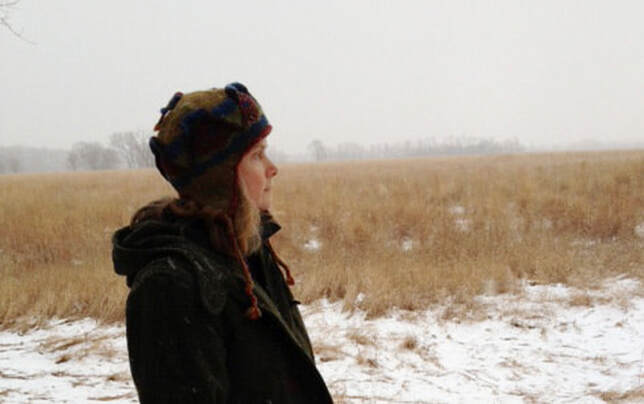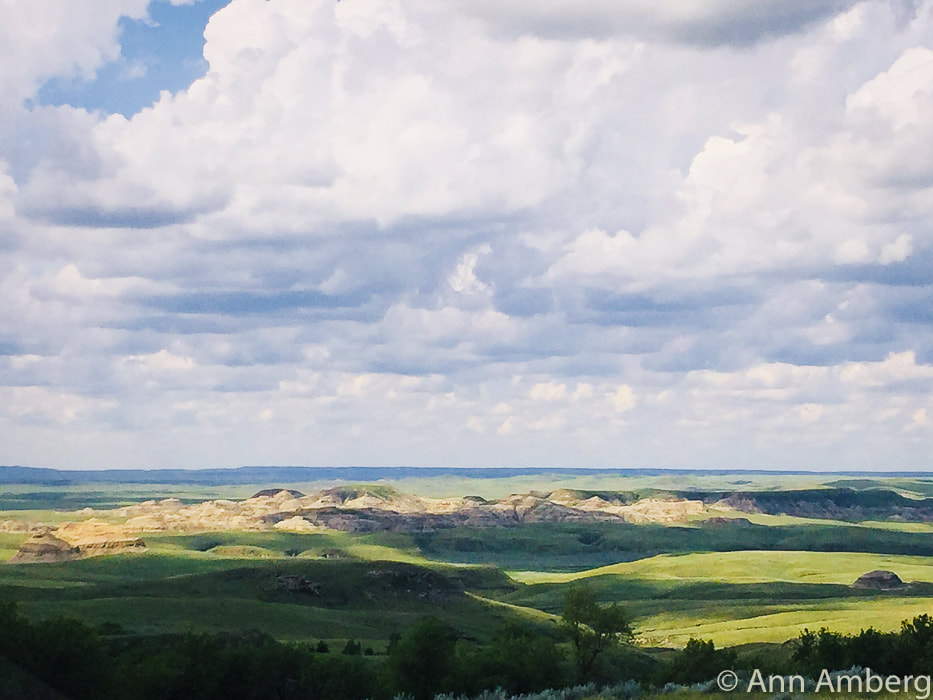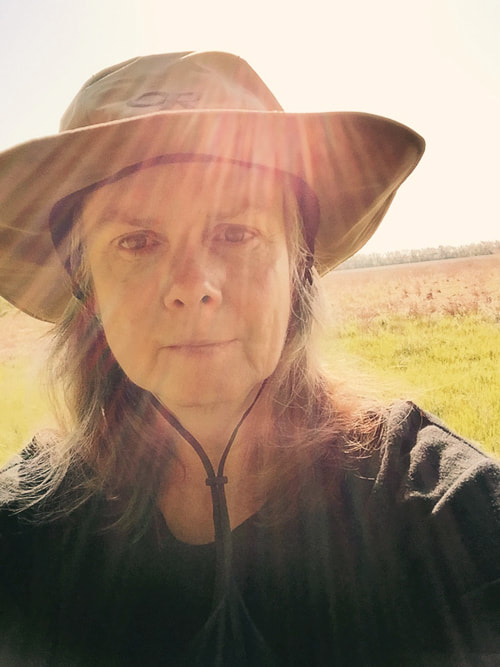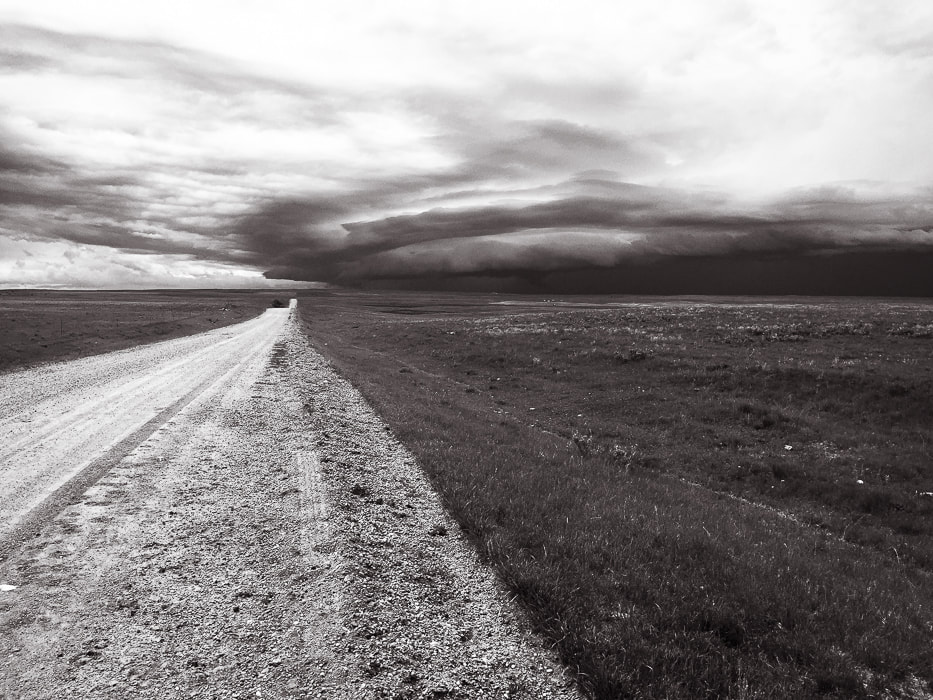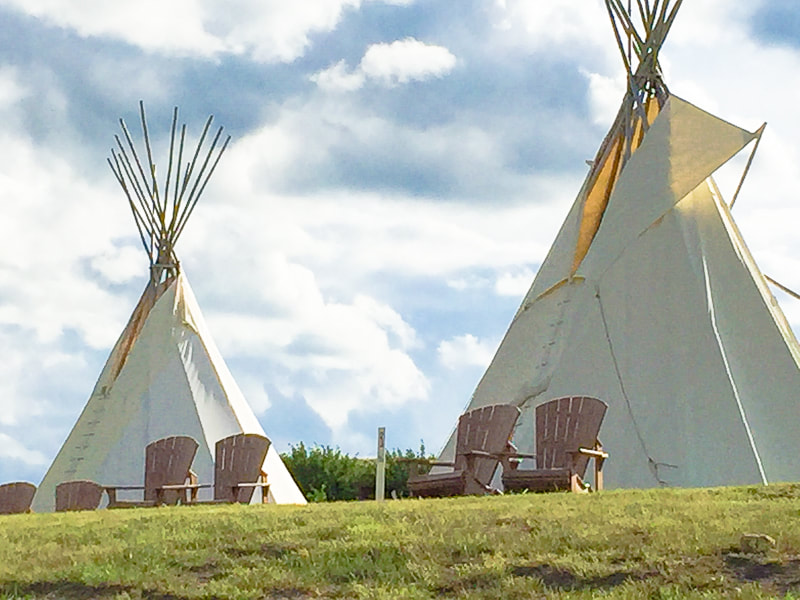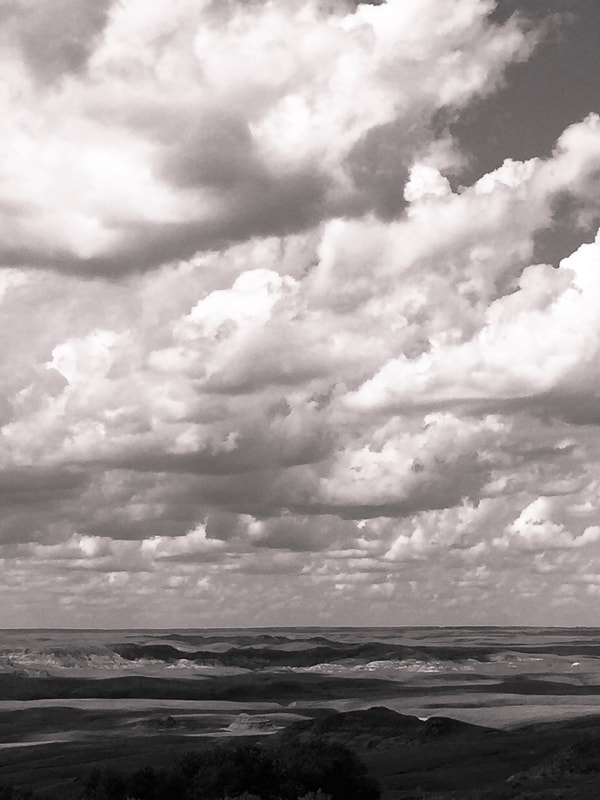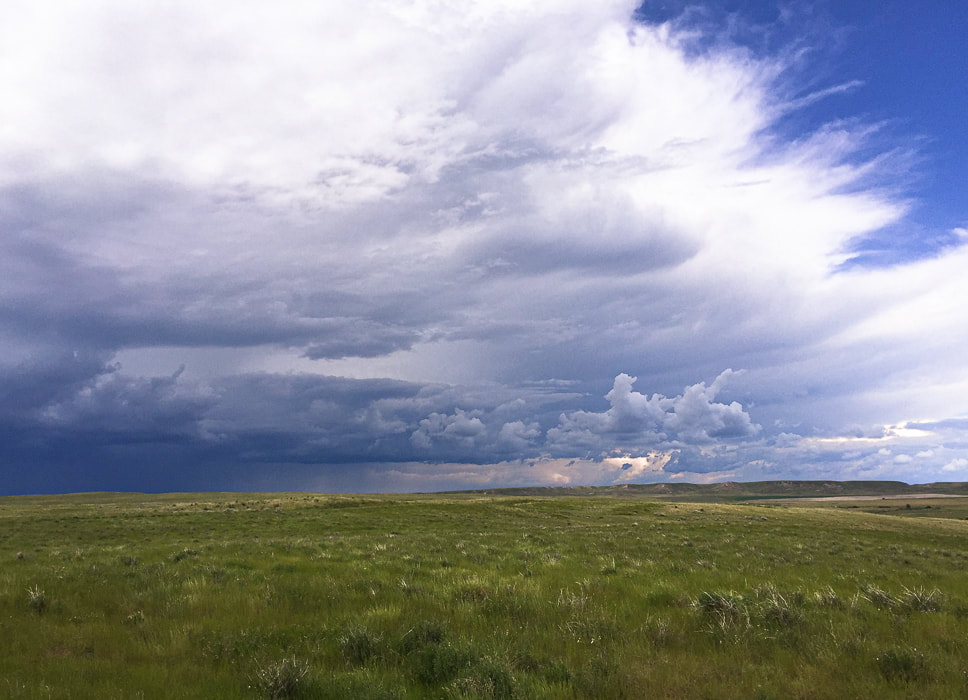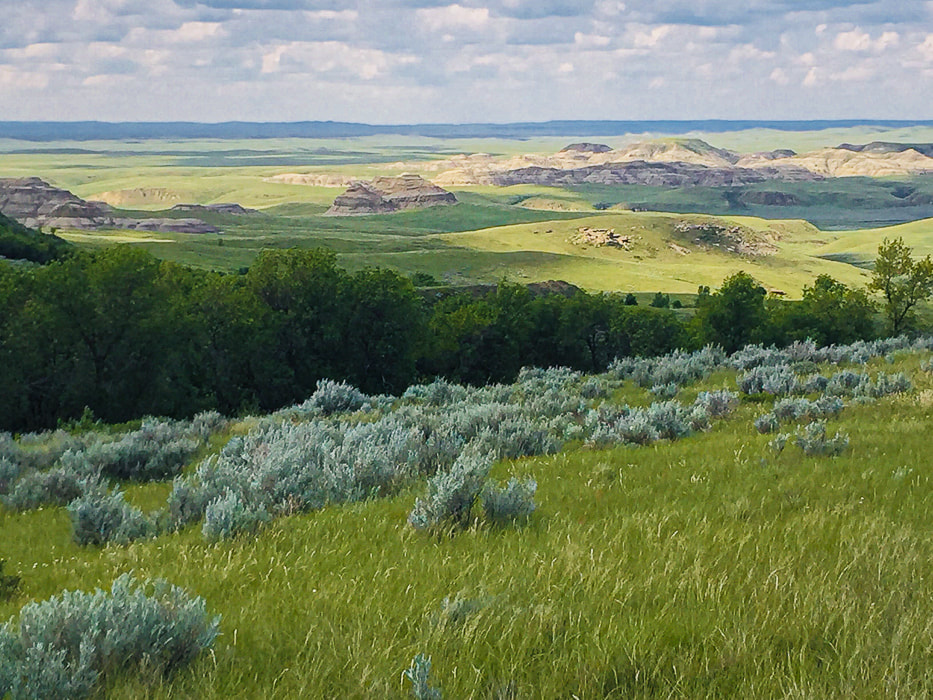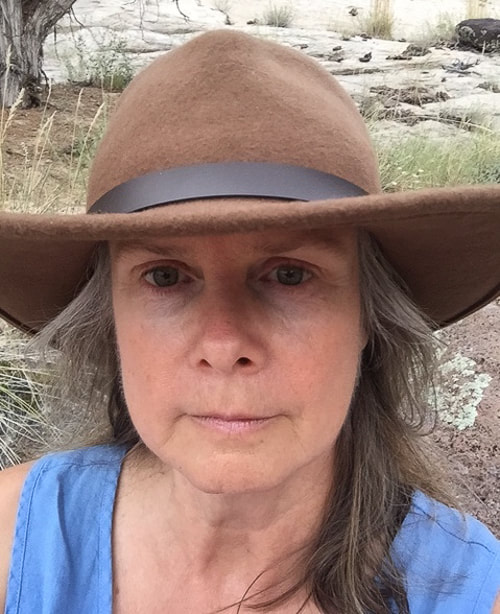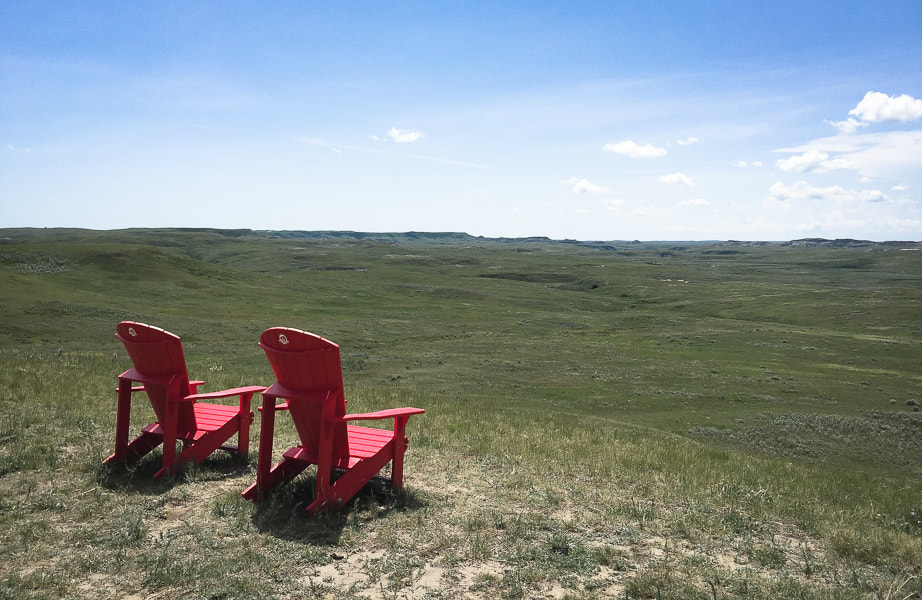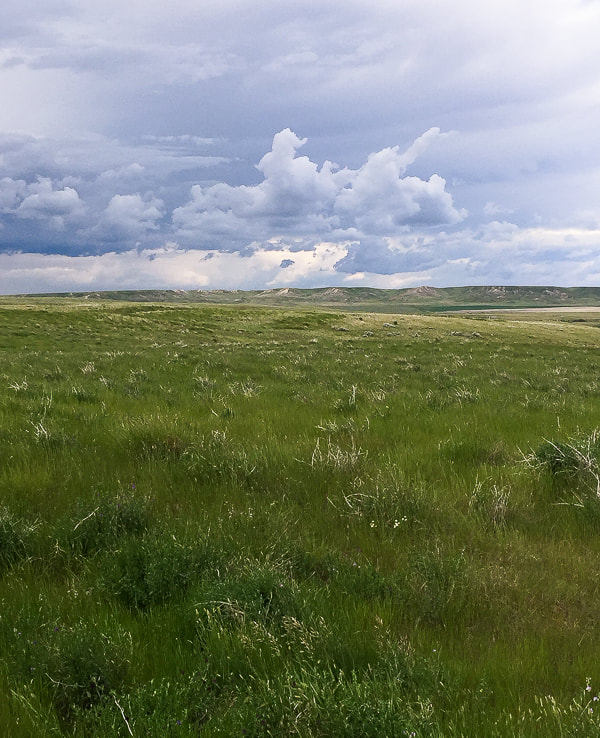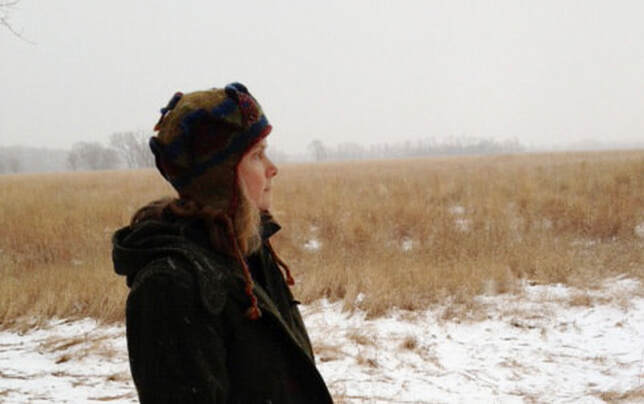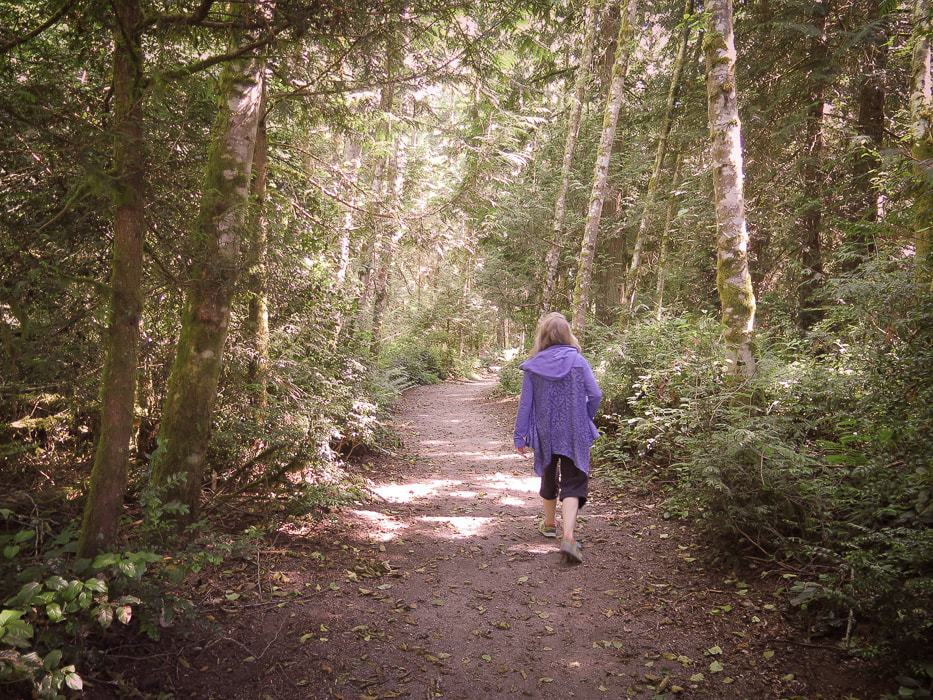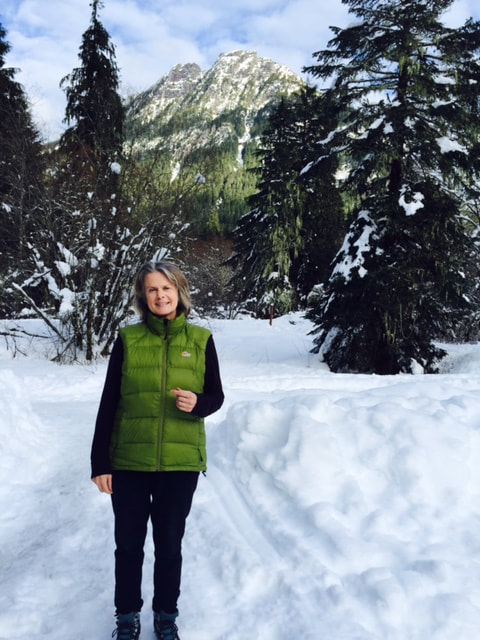|
Ann Amberg found the embodiment of freedom and beauty while exploring the land in Grasslands National Park on the Saskatchewan prairie; she describes it as "a spiritual event." Photos by Ann Amberg Grasslands National Park, West Block - Southern Saskatchewan, Canada The summer day on the Saskatchewan prairie dawns softly with pink clouds stretched over a light turquoise sky letting go of its last stars. Ann Amberg pulls back the entrance flap to her teepee and steps outside to survey the still, undulating expanse of prairie grasses and gently dipping tree-lined streams. This July morning, she will venture to one of the only black-tailed prairie dog colonies left in Canada. This "keystone" species, a member of the squirrel family, was once on the decline, but conservation efforts by Grasslands National Park have helped to increase their numbers. Ann visited prairie dog colonies a few years ago at Niobrara State Park in Nebraska, where she witnessed their playful and social antics. The Saskatchewan prairie, despite the absence of dramatic towering cathedrals that define the Rocky Mountains and the deep red and yellow canyons that define Southern Utah, possesses its own grandeur. Mixed grasses give an undulating golden and green softness in texture; its river valleys provide relief and vertical lines to the prairie's horizontal expanse. It is on the prairie that soul and spirit are revived as the eyes meet its grand openness and space. It is a place with a deep history of its inhabitants. John C. Van Dyke's quote from The Desert can also be applied to this prairie expanse: "There is something very restful about the horizontal line. Things that lie flat are at peace and the mind grows peaceful with them." The prairie is also a land of extremes as anyone who sets out in the morning on a pleasant walk only to scramble for shelter in the open landscape during a sweeping and pelting thunderstorm can attest. Midsummers on the Saskatchewan prairie can be brutal. A sunny and pleasant rolling grassland dotted with the slow motion of cloud shadows moving across its wide landscape can change to darkness, lightning, severe winds and sheets of rain that make roads impassable. A feeling of exposure and vulnerability prevails: temperatures often in the high 80's, high humidity, scorching sun, and paucity of shelter. Not many choose Grasslands National Park for a summer vacation. Except for Ann, who this past July drove 1,000 miles from her home in the lush and wetter Pacific Northwest because she felt drawn to this prairie, primarily to be surrounded by its moods, its openness, its strength and its gentle mornings, like this one. Ann went to the prairie with no agenda, rather she went ". . . to do nothing, to feel intimacy with the land, to have a conversation with the land . . . to just be." Totally immersing herself in this this native grassland, she let her intuitions and feelings guide her actions as she observed the prairie. She chose to go there because she wanted to connect with something bigger than herself, something mysterious, and as she puts it, "The Other." Ann connects to the prairie's vast panoramas because, "I feel like I have all the room for my spirit and soul to spread out." Ann Amberg The land that is Grasslands National Park is a small part of the Great Plains Grassland ecosystem, including various grasslands that extend from southern Canada to Texas. It is old-growth prairie with relict vegetation such as blue gramma grass, the bison's favorite food, and needle-and-thread grass with its sharp awns. Frenchman River, a focal landscape feature in the West Block of Grasslands, was created by an ice stream as a result of the last glacial retreat, more than 10,000 years ago. This park is also noted for the darkest Dark Sky Preserve, designated in 2009. Ann emerged from her teepee one early morning to see the amazing sight of a black sky engulfed in crystal clear and bright stars on a new moon night. As she stood and looked up, she felt disoriented surrounded by the enormity of this black and white expanse. Grasslands National Park preserves a small portion of the native mixed-grass prairie that remains, so it is the best representation of the Prairie Grasslands Natural Region. Only one percent of the native mixed-grass prairie is present in its original state in North America, making it the most imperiled ecosystem. Honoring every bit of life around her, Ann was "completely available to all the information coming into me from every level of being on the prairie." This is a part of her lifelong practice - to be completely available psychically and in body, observant and conscious of what is around her. "My world view is that everything is alive and conscious." To Ann, the prairie is the embodiment of freedom and beauty. Really taking the time to observe, feel and allow yourself to be absorbed into a relationship with elements of the natural world is a soul-fulfilling practice. "There's so much going on: so many sounds to hear, gradations of color and texture. To look at the tiniest flower and then to open my vision to the longest view you could get anywhere - it is a meditation." The traditional and the modern at Grasslands National Park in Saskatchewan For 40 years, I have seen Ann's progress with understanding the many aspects of the human's relationship with and connection to our natural lands. She has done extensive work on this subject and her knowledge has matured so that she is a great resource for me (and others) in my quest for a deeper relationship with nature and the universe. She has devoted her life and career to this, and now through her, I am attuned more than ever to my own relationship with nature, with what I call "the land." I attribute my appreciation and awareness of the land's voice to Ann, who took me on a few hikes in Fontenelle Forest near Omaha, Nebraska, when we were in high school. A walk together in a snowy Colorado forest a few years later was a turning point in perceiving the natural world around me resulting in a feeling of calmness and fulfillment, that nature would always be important to me. As we sat on a large tree trunk in the snow and closed our eyes, we listened for sounds only within a few inches of us, then sounds within 10 feet, and finally sounds beyond that. It was a simple exercise that significantly changed my perception of the natural world and the beginning of an intimate relationship with nature that has grown over time. It was a pivotal experience, and a cherished memory. Throughout the years, we have shared our various natural experiences. I fell in love with the deserts of the southwest, she with the wild mixed-grass prairies of Nebraska and Canada. Driving one afternoon across Grasslands National Park, Ann met with what she describes as an "exhilarating" storm, a wall of black clouds, lightning flashes and strong winds, so strong she felt she might be blown off the road. As she found shelter in a small town, she saw a herd of horses running with the driving wind. They stopped and formed a tight circle around the small foals to protect them, looking to the horizon, ears alert. The storm passed in ten minutes; the scene changed again. Ann describes this experience not as frightening, but thrilling as she felt the storm's strength and power, and grateful to witness and feel the horses' reaction. The summer Saskatchewan prairie is "radiant" in the literal sense: Over 300 days per year have some hours of sunshine and July is the sunniest month. But some feel the radiance of this land through its spiritual dimension, its spiritual energy; it comes from the land itself. Ann, because she seeks to be fully present so that the land is inhabiting the wholeness of her spiritual energy, feels the prairie receives her presence and spirit, and is fully present to her in return. "My experience on Earth is a very deep mysterious experience - a soul-level experience. This helps me to be a happier, more whole and vital person. It's positive psychologically. I have a feeling of wholeness; I feel larger than I am - larger than my ego. It's a spiritual or mysterious part of my psyche that is instinctual and goes way back." In modern times, most humans have slowly severed their connections to the Earth. "If we were able to get in touch with the hunter - gatherer self in our psyche, then we could begin to embody and live out the wild parts of ourselves - those parts of ourselves are dying to be recognized and acknowledged and assimilated." It requires we go beyond the rational ego, that we open our "sensory gates" to be aware of what we feel intuitively, subconsciously, as well as physically about what we see in our natural world. For most of her life, Ann has been developing her practice of understanding the many levels of the unconscious as it relates to nature and every form of life. Childhood experiences on the open Nebraska prairie are lasting imprints; even as a child she was aware of how this wild, open space made her feel. The exposure she felt walking in a sea of grasses with the horizon all around exhilarated her; now she realizes she had a soul-level connection with this land. "It is so vast, yet quiet and peaceful, a land full of paradox, change, and drama. My soul feels free, because it is so plain and simple - just the wind and the land." She remembers how it felt to look west, outside her childhood house on the edge of town to the incoming thunderstorms spreading over cornfields. It was perpetually windy and winters were raw. The vivid scene of a racing herd of pronghorn antelope is imprinted in Ann's childhood memory. As her family drove through the open Nebraska prairie, the pronghorn kept up with the car's speed. Their beauty, wildness and freedom made an impression on her. Even as a child, she became connected to the wild and extreme prairie, feeling confidence and a sense of inner spaciousness. There is a black and white photo of her, taken by her father, standing in prairie grasses, looking up to an abandoned farmhouse. Mixed-grass and sagebrush at Grasslands National Park, Saskatchewan Ann is an artist who works as a consultant in leadership development. She is a Deep Imagery practitioner, who guides people on self-directed inner journeys to work on solutions for a variety of personal goals. Even though Ann has lived for years in the Pacific Northwest with its dense forests and limited views of the horizon, it is the pronghorns, burrowing owls, prairie dogs, waving grasses, and the wide-open gently undulating land of the native prairies that reside deepest in her heart. Check out Ann's website, annamberg.com to understand much more of Ann's soul-level practice, publications and workshops she has conducted. Ann conducts webinars on Practicing Partnership with the Earth through the Center for Partnership. Grasslands National Park, Saskatchewan At De Soto National Wildlife Refuge, Nebraska Ann on walk through Earth Sanctuary - Whidbey Island Snoqualmie National Forest, Washington
1 Comment
11/8/2023 11:03:48 pm
I wanted to express my gratitude for your insightful and engaging article. Your writing is clear and easy to follow, and I appreciated the way you presented your ideas in a thoughtful and organized manner. Your analysis was both thought-provoking and well-researched, and I enjoyed the real-life examples you used to illustrate your points. Your article has provided me with a fresh perspective on the subject matter and has inspired me to think more deeply about this topic.
Reply
Leave a Reply. |
Author
|
